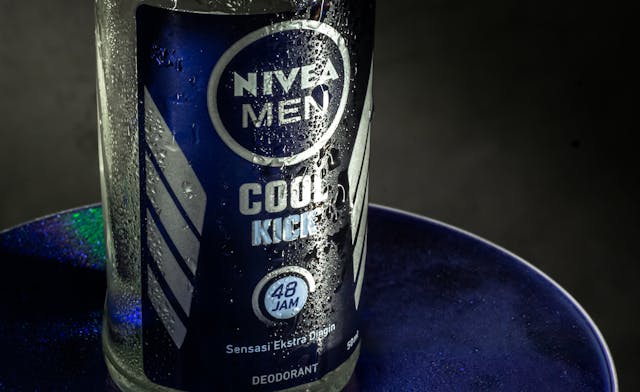
How does deodorant work? There are three ways that deodorants work. They can cover the smell of sweat with a scent, they can kill the bacteria that make the smell, or they can reduce the amount that a person sweats.
When the summer comes around, we all sweat. Some people sweat more than others, and that can be down to a host of factors. Sometimes its just genetics, but it can be body size, the amount of exercise you do, the materials you are wearing, and even what you have just eaten. We might not enjoy it, but we need to sweat. It is our body’s natural way of cooling down. The sweat glands release fluid onto our skin, which evaporates, taking energy away from our body with it. If you couldn’t sweat and the weather was hot, you would very quickly overheat, and hyperthermia would set in, which can be fatal. We have sweat glands all over our bodies, but we have two types. Eccrine glands are the most common and they produce an odorless, clear fluid straight onto the skin that controls our temperature. Then we have apocrine glands, which are generally found in the armpits and groin. These produce thick, milky colored fluid, and they secrete it through hair follicles. Apocrine sweat glands aren’t responsible for keeping us cool, but they are responsible for the smell that comes with sweat. The milky fluid that they produce is full of nutrients, proteins, and fats that the bacteria on our skin love. The bacteria break down this fluid, and they produce chemicals that have a strong odor as a result. This chemical is where the smell of sweat comes from. The main bacteria that do this are Staphylococcus, but there are others. They produce volatile fatty acids and thioalcohols, both of which have a bad smell. They tend to accumulate in our armpits because it is nice and warm there, which they love. The smell they produce is the smell that deodorants attempt to remove.
The first type of deodorants simply use a scent to mask the smell of our sweat. This is the same principle behind any perfume. Add a stronger, more pleasant scent, and we won’t be able to detect the nasty smell it is disguising. These scents might come from essential oils, spices, or other natural products. They might be created in a lab. Whatever they are, they will only work for a while and will wear off. They will also not be able to mask very strong smells.
The second type of deodorants kill the bacteria that produce the smell. As we said, the sweat itself doesn’t smell, it is the bacteria that produce the smell. If you can get rid of the bacteria, you can get rid of the smell. Deodorants can do this with antimicrobial agents, alcohol, or acids. A common antimicrobial agent is triclosan, but there are others. Triclosan is also found in soap and toothpaste, and it works by breaking the bacterial cell wall. It is effective, but bacteria are becoming resistant to it, as they are to all antibacterial drugs. Alcohols work by drying out the area and by killing the bacteria. And the acids work by increasing the natural acidity of our skin. Bacteria cannot survive in very acidic environments. These deodorants will only prevent smells for as long as the material they use is still present. Once it is gone, the bacteria will come back.
And the last type of deodorants are called antiperspirants because they stop perspiration. Most antiperspirants contain a type of aluminium of some sort. This is usually aluminium chloride. It mixes with the other chemicals in the deodorant and creates a sticky substance that plugs the sweat glands that it is sprayed on. This is called a colloid. That is when particles of one substance are suspended in a liquid or gel of another substance. This blocks the pore, but it also causes it to contract slightly, making an ever tighter bung. Sweat cannot get out through the blocked pores and therefore there is no sweat for the bacteria to feed on. The pore will slowly unclog, which is why antiperspirants are usually rated for a certain number of hours. Once the bung has come out, the sweat will emerge again.
There is actually some ongoing research into bacterial transplants. Some people have bad smelling sweat and some people sweat a lot but their sweat doesn’t smell. Research has shown that if you take some of the bacteria from a person whose sweat doesn’t smell and place it in the armpit of someone whose sweat does smell, the smell often goes away. This research is ongoing. It is fascinating. And this is what I learned today.
Sources
https://www.nivea.co.uk/advice/skin/how-does-deodorant-work-172
https://en.wikipedia.org/wiki/Deodorant
https://en.wikipedia.org/wiki/Triclosan
https://en.wikipedia.org/wiki/Colloid
https://en.wikipedia.org/wiki/Sweat_gland
https://www.bbc.com/future/article/20131011-how-does-deodorant-work
https://asm.org/articles/2021/december/microbial-origins-of-body-odor
https://www.sweathelp.org/home/understanding-hyperhidrosis.html
https://freshmonster.com/blogs/guides/how-does-deodorant-work
Photo by Nur Andi Ravsanjani Gusma: https://www.pexels.com/photo/close-up-of-a-nivea-men-deodorant-5983409/
